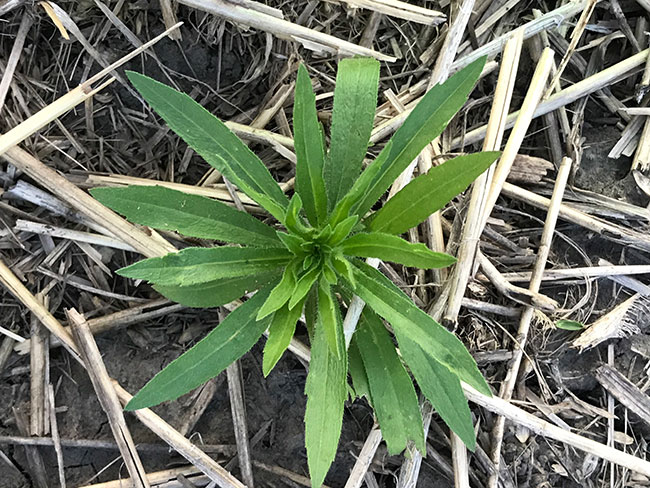
Features
Herbicides
Weed Management
Challenging times for glyphosate
Can agriculture learn to live without the “unicorn” product? Does it have to?
March 20, 2023 By Julienne Isaacs
 Canada fleabane is a problem across North America and other parts of the world; glyphosate-resistant Canada fleabane is widespread.
Photo courtesy of Tammy Jones, Manitoba Agriculture and Resource Development.
Canada fleabane is a problem across North America and other parts of the world; glyphosate-resistant Canada fleabane is widespread.
Photo courtesy of Tammy Jones, Manitoba Agriculture and Resource Development. Few agricultural products have global name recognition like glyphosate. The broad-spectrum, systemic herbicide has been in use since 1974, when Monsanto commercialised it under the trade name Roundup.
According to a 2017 Health Canada document on the re-evaluation of glyphosate, it’s the most widely used herbicide in Canada. Around the world, its use is on the increase, according to 2022 market reports.
Glyphosate is a kind of “unicorn” product thanks to a variety of factors, says Eric Page, a research scientist with Agriculture and Agri-Food Canada (AAFC). Glyphosate is easy to use and inexpensive. There are few other chemistries that have the same efficacy three seasons of the year – as a pre-emergent burndown product, in-crop on glyphosate-resistant crops, and as a pre-harvest aid.
“[For] pre-seed burndown we have only a single alternative product, glufosinate,” says Page.
Because of this, glyphosate is almost never completely cut out of a weed management program: what happens more often, he says, is that producers keep it in the same use pattern while adding other products to control escapes.
“So maybe where your burndown used to be seven dollars an acre, you’re having to add more expensive products to get back that efficacy. But glyphosate is still the bedrock of that,” Page explains. “Analogously, if you move into in-crop applications, we’ve seen the development of next-generation herbicide tolerance traits, and [those are] stacked on top of resistance to glyphosate in corn and soy.”
Page, with AAFC research scientist Robert Nurse, gave a presentation on challenges facing glyphosate at last year’s Co-operative Program in Research and Technology for the Northern Region (Procinorte), a trilateral network comprising the federal agriculture departments of Canada, the United States and Mexico.
Thanks to its ubiquity, glyphosate resistance continues to spread in Canada, Page and Nurse stated in their presentation.
Between 2013 and 2018, to name just one example, the percentage of kochia in Manitoba that showed a level of resistance to glyphosate jumped from one per cent to 58 per cent.
Alternatives
A recent research study conducted by University of Guelph scientists Peter Sikkema, Nader Soltani and others, which aimed to estimate potential economic losses due to glyphosate-resistant (GR) weeds in Ontario, concludes, “the annual loss of farm-gate income from GR volunteer corn would be $175 million, $104 million from horseweed, $11 million from waterhemp, $3 million from giant ragweed, and $0.3 million from common ragweed, if these are left uncontrolled in the main field crops grown in Ontario, for a total of $290 million.”
But there are significant costs associated with adjusting weed management programs to prevent major crop losses due to the presence of glyphosate-resistant weeds, the authors add. “This study estimates that glyphosate-resistant weeds would reduce the farm-gate value of the major field crops produced in Ontario by $290 million annually if Ontario farmers did not adjust their weed management programs, but with increased herbicide costs of $28 million and reduced crop yield loss due glyphosate-resistant weed interference to five per cent the actual annual monetary loss in Ontario is estimated to be $43 million annually.”
Apart from costly issues with resistance, glyphosate has an image problem. Page says that, due to public attention to the question of glyphosate’s safety for the environment and human health, changes in public tolerance for crops that are exposed to glyphosate have impacted value chains.
Page says the problems plaguing glyphosate are well-documented and understood. The identification of alternatives is a far more difficult task.
In their presentation last year, Page and Nurse reviewed a host of possible alternatives, including chemical (the use of multiple modes of action and a possible return to older modes of action), biological (genomics), cultural (cover crops, intercropping and rotation) and physical or mechanical (tillage, harvest weed seed control, robotics and electrocution or lasers).
In recent years, Agriculture and Agri-Food Canada has placed a strong emphasis on the latter option. Alberta AAFC scientist Breanne Tidemann’s work on harvest weed seed control, including the Harrington Seed Destructor, is one example.
Nurse’s investigation of electrocution treatments for weed control is another. Weed electrocution research has been ongoing in Europe and the United States for a few years; in Missouri, it’s been investigated as part of a glyphosate-resistant waterhemp control strategy. Nurse is looking at applications in dry edible beans.
The goal of all this research isn’t to completely remove glyphosate from the picture, but rather to keep the product in use as part of an integrated management package.
“One pillar of integrated weed management is chemical control rotation or alternatives,” says Page. “That’s important because it provides a short-term solution for addressing the farmer’s problem: they have an escape, they need to manage it.”